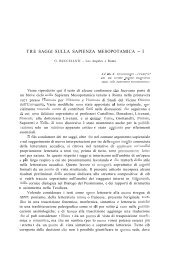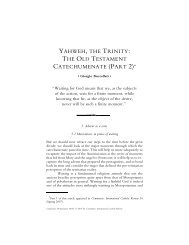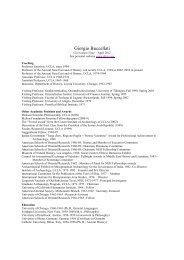Akkadian and Amorite Phonology
Akkadian and Amorite Phonology
Akkadian and Amorite Phonology
You also want an ePaper? Increase the reach of your titles
YUMPU automatically turns print PDFs into web optimized ePapers that Google loves.
<strong>Akkadian</strong> <strong>and</strong> <strong>Amorite</strong> <strong>Phonology</strong> 21S is the symbol for a lateral that is reconstructed for Proto-semitic,''but is not preserved as such in either <strong>Amorite</strong> or ~kkadian." Even thoughit is used often in the Assyriological literature, this notation should be avoidedwhen dealing with those two languages.S is a symbol I am using to render what I assume to be a distinctive<strong>Amorite</strong> phoneme, at least in terms of its derivation. The <strong>Amorite</strong> phonemecorresponds to "Proto-Semitic" "S <strong>and</strong> "i. Though it is often transliteratedas 6, it does not appear to be a lateral,12 because of the writing with signs ofthe class SA. It seems possible to postulate a phonetic developn~ent similarto Arabic, i.e., a change in the direction of s,13 with place of articulationshifting toward the dental position. But that it could not simply havemerged with s is also indicated by graphemic consideration^.'^ Hence I ampostulating, on a purely indicative basis, that this phoneme may have beenrealized as a denti-alveolar fricative. At any rate, the phoneme is distinctfrom any other in terms of its correspondences (i.e., it corresponds to "S<strong>and</strong> *i, but not to *I), <strong>and</strong> this by itself is sufficient to justify the use of adifferent symbol.1 is the symbol used for the voiceless interdental fricative (e) in theposited proto-form. The Old <strong>Akkadian</strong> correspondence is generally transcribedas iin the literature, but, since there is no reason to assume a lateralrealization for this phoneme in Old <strong>Akkadian</strong>, I prefer to retain consistentlythe notation _ton the assumption that the original interdental realization waspreserved. 1510. The autonomy of this phoneme for "Proto-Semiticn is controversial, but it can at leastbe safely postulated as an antecedent to <strong>Amorite</strong> <strong>and</strong> Old <strong>Akkadian</strong> (Gelb 1961: 34f.).11. Except possibly in Old <strong>Akkadian</strong>, see Reiner 1966: 110; Greenstein 1980, with reviewof previous literature; also Diakonoff 1985: 22, where the notation d is used. The strongestindication in its favor is based on the explanation of the assimilation $+S > ss as presupposinga second consonant S, see S 1.4.3, where I also give reasons why it seems nevertheless betternot to include it in the st<strong>and</strong>ard phonemic inventory.12. As Greenfield 1969: 94 seems to suggest, on the assumption that *$coalesced with *S, sothat both came to pronounced S.13. Knudsen 1982a: 5 says that its phonetic realization is "similar to Old Babylonians."Gelb does not address the issue of articulation for this phoneme.14. To render 9, signs of the SA class are used next to signs of the SA class, <strong>and</strong> only signs ofthe AS class are used. To renders, only signs of the SA <strong>and</strong> AS classes are used.15. "Possible pronunciation in the direction of Arabic 1, perhaps not in Mesopotamiaproper but in an outlying region" (Gelb 1961: 37). In the chart in ibid. p. 39, the "sound" ofthis phoneme is indicated as 1: which, according to the discussion on p. 33, would seem tost<strong>and</strong> for an aspirated correlative of _t.







